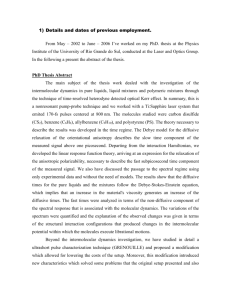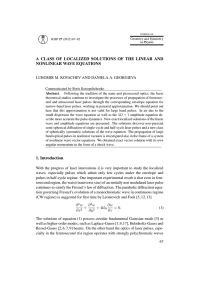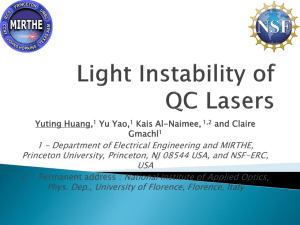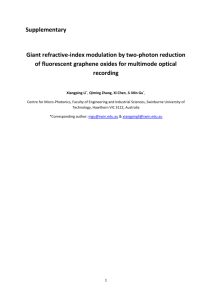Ultrashort Pulsed Laser Light
advertisement
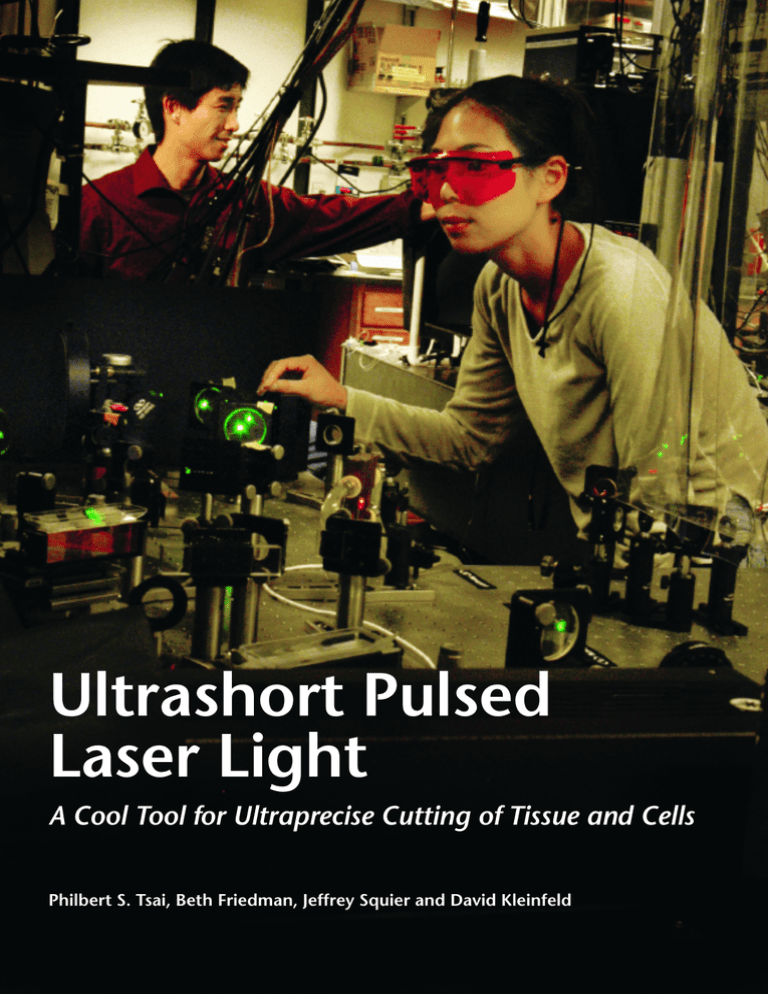
Ultrashort Pulsed Laser Light A Cool Tool for Ultraprecise Cutting of Tissue and Cells Philbert S. Tsai, Beth Friedman, Jeffrey Squier and David Kleinfeld The virtues of being ultrashort Ultrashort pulsed laser light is being used to cut through biological tissue in a highly localized and controlled manner. Practical applications include an all-optical technique for automated, three-dimensional histology of brain tissue and the optical permeabilization of living cells for photo-addressable plasmid uptake and gene transcription. Use of ultrashort laser pulses as an ultraprecise scalpel fits well with application of lower-powered laser pulses for imaging by two-photon laser scanning microscopy. H ow does one gain understanding of the inner workings of a complex device? A time-honored method is to remove part of the casing to access its internal parts. One can then go in with diagnostic tools or disable a particular component to gauge its function. This reverse-engineering principle has been used with great success in the biological sciences to explore everything from the systemic properties of whole animals down to the inner workings of cellular organelles. Of course, having the right tool for the job is essential because the tool also serves to drive the process of biological inquiry. The bioresearcher’s toolbox consists of techniques that range from the mechanical and the electrical to the biochemical. One method that has begun to play a role is the use of ultrashort laser pulses to achieve precise, targeted cutting of tissue and organelles. The use of lasers to ablate or remove tissue has seen a wide variety of clinical applications. In most of these, ablation relies on thermal accumulation in tissue by absorption of laser light. Although such thermal buildup mechanisms are suitable for some clinical applications, the resulting collateral tissue damage represents a serious drawback to their use as a basic research tool. As an additional consideration, many biological tissues both weakly absorb and weakly scatter light at the visible and near-infrared wavelengths of most lasers. In such semitransparent tissues, the three-dimensional (3D) confinement of laser-tissue interactions is problematic because linear interactions can occur over the entire axial path of the laser beam. Still, the submicrometer lateral confinement of laser light holds great allure as a precision tool to manipulate biological systems, a factor which has prompted researchers to look for ways to facilitate the 3D confinement of laser-induced damage and to reduce collateral tissue damage. These considerations have not been unique to biological applications. Similar constraints arose when material scientists addressed the need for precise ablation of transparent dielectric materials. The problem was solved with the use of ultrashort (~100 femtosecond) laser pulses. This approach allowed them to take advantage of nonlinear interactions to produce precise, localized damage either at the surface of a dielectric1-4 or deep within its bulk.5, 6 Biophysical researchers have since adopted these methods for the manipulation of tissue7-15 and cells.16-18 Ablation Pulse mechanisms width ` Boiling ms Laser interactions that require significant distortion of the electronic properties in a material, or that require the simultaneous absorption of multiple photons, scale nonlinearly with laser intensity. As a result, the interaction volume is confined to regions of high laser intensity, typically near the focus of a pulsed laser beam. The nonlinear interaction of particular relevance to the precise manipulation of tissue is plasma-mediated ablation. Ongoing research on the physics of this mechanism4, 19 suggests that the optical field of the ultrashort pulse leads to a high rate of tunneling by electrons from the valence band to the continuum to form an electron plasma. The density of this plasma rapidly builds up by virtue of additional tunneling as well as fielddriven collisions between free electrons and molecules, a process known as avalanche ionization. This increase in electron density leads to absorption of laser light over a distance that becomes thinner with increasing density. The thickness of this layer approaches a value that is much less than the depth of the focal volume. The absorption of laser light by this thin layer leads to highly localized ablation and the explosive removal of material. Near-infrared pulsed lasers that package energy into subpicosecond pulses are Energy deposition Linear electronic absorption Linear vibrational excitation ms Phase change with explosive equilibration ns ps Plasma Linear and nonlinear electronic absorption fs Nonlinear absorption leading to plasma creation 0.1 to 1 mm (electronic bandgap) Defect or thermal seed Self generated seed Wavelength 10 to 100 mm (molecular vibration) Figure 1. Schematic characterization of different regimes of laser energy deposition and damage mechanisms. Tell us what you think: http://www.osa-opn.org/survey.cfm July 2004 ■ Optics & Photonics News 1047-6938/04/07/0024/6-$0015.00 © Optical Society of America 25 ALL-OPTICAL TISSUE CUTTING Serially ablated tissue Reconstruction from optical sections Stain tissue Stack of optical sections Ablate and restain tissue Ablate and restain tissue Figure 2. Illustration of the iterative process by which tissue is imaged and ablated in alloptical histology. A sample containing fluorescently labeled structures is imaged with multiphoton microscopy to a depth of 100 micrometers or more. The imaged tissue is then removed with amplified, ultrashort laser pulses to expose a new surface for imaging. Tissues that lack intrinsic fluorescent labeling can be stained between iterations. [Adapted from Ref.15.] 0 -100 -200 Depth, z [mm] particularly attractive sources for nonlinear laser-tissue interactions (Fig. 1).20-22 A critical feature of plasma-mediated ablation is that infrared light has insufficient photon energy to drive the linear excitation of most endogenous biological molecules or exogenous fluorescent markers. For this reason, light outside the focal volume has little detrimental effect on the specimens. Second, because the laser energy is packaged into extremely short pulses, the high peak powers necessary to efficiently drive nonlinear processes are attainable at relatively low average powers. This helps limit the thermal build-up and ensuing collateral damage in the targeted material, whether it is glass or a biological specimen. Last, the high peak intensities achieved by ultrashort laser 26 Optics & Photonics News ■ July 2004 pulses allow the pulse to generate its own seed electrons by the tunneling mechanism described above. This is in contrast to ablation with longer pulses and corresponding lower peak powers, for which ionization relies on the availability of thermally activated free charge carriers or the presence of lattice defects in crystals. The rate of ablation with ultrashort pulses is therefore highly regular and results in precise and efficient cutting. Clinical applications that exploit such ablation mechanisms are under extensive study, most notably for eye surgery.23-26 Preliminary research is being done to explore applications in ear surgery 27 and dentistry.28, 29 Of equal importance are the opportunities that ablation with ultrashort pulses present for basic biomedical research. With this new tool in hand, researchers have begun to pick apart the machinery of biology, achieving new insights in the process and opening the door to novel lines of research. New tools for biology The study of biology can broadly be divided into two approaches: the study of structure (histology) and the study of function (physiology). The two are complementary and highly intertwined, with structure often leading to function and vice versa. The ablation of tissue with ultrashort laser pulses has the demonstrated potential to be used in both realms. Researchers have performed ablation in two different regimes, using two distinct sets of laser parameters. In the first regime, one or a few submicrojoule pulses are used to remove large volumes of tissue. These pulses are formed by an optical amplifier with a typical repetition rate of 1 to 5 kHz and are delivered to the selected site under tight focusing (NA ~ 0.1 to 1.0). Applications in this regime are exemplified by the automated study of neuronal architectonics. In the second regime, the approximately 80 MHz repetition rate pulses from a laser oscillator are used without further amplification for subcellular disruption. In this regime, thousands to millions of subnanojoule pulses are delivered to a single target volume under extremely tight focusing conditions (NA > 1.0). Applications in this regime are exemplified by the precision surgery of cell membranes and organelles. All-optical histology: just a light shave Traditional methods in the study of structure involve the mechanical slicing of fixed tissue into a series of sections. The tissue sections are stained with a contrast agent, mounted and imaged as individual samples. The traditional techniques are extremely labor intensive and the tissue sections involved are prone to damage and distortion. Three dimensional reconstruction of structural architectonics is rarely performed because warpage and the loss of registration make the process non-trivial. Meanwhile, technical advances and automated processes in molecular biology have unleashed a ALL-OPTICAL TISSUE CUTTING Figure 3. Two-photon microscopy images of tissue structures exposed by cutting with amplified ultrashort 500 mm laser pulses. The cranium of a perfused and fixed embryonic mouse has undergone ultrashort ablation and staining with a 10 mm 50 mm fluorescent nucleic acid stain prior to imaging. The low magnification view shows preservation of gross features, including the skin, bone, cortical mantle and the underlying ventricle (top left). The intermediate magnification highlights the cellular constituents of the cut tissue (bottom left). The highest magnification highlights dividing chromosomes in individual cells of the still immature brain; this illustrates the preservation of subcellular structures subsequent to ablation of tissue with amplified ultrashort laser pulses. [Adapted from Ref. 15.] Axial depth z [mm] plethora of genetically altered animals in which specific structures are labeled, most recently with functional indicators.30, 31 A need to map the varied distribution of protein expression in this growing population of animals has emerged. As a means to automate tissue analysis, an all-optical histological process by use of ultrashort laser pulses has recently been demonstrated.15 All-optical histology dispenses with the mechanical steps in histology by the sequential application of multiphoton microscopy32-34 and ultrashort pulsed laser ablation of tissue for the purpose of tissue analysis, as illustrated in Fig. 2. Multiphoton microscopy is used to image fluorescently labeled structures as deep into the tissue as possible, e.g., to a depth of ~150 mm in fixed neural tissue. Ablation with ultrashort pulses is then used to remove the previously imaged tissue to allow optical access to deeper underlying structures. Importantly, the regions of interest are imaged in situ while connected with the surrounding tissue. Tissue ablation with ultrashort pulses was found to be fully compatible with multiphoton microscopy for tissue histology. The ablated surfaces were physically smooth to within a micrometer and, as shown in immunological labeling, proteins within a few micrometers of the ablated surface could be recognized with antibodies. Macroscopic features as well as microscopic structures were found to be resilient to the ablation process. In particular, as illustrated in Fig. 3, the ablation and subsequent imaging of fragile embryonic tissues demonstrate that, with this methodology, even very friable tissue is structurally preserved both at the gross and fine structural levels. The acquisition of data to form a complete volumetric reconstruction of tissue enables 3D analysis of anatomical structures. Statistics on many important biological variables, most notably cell number and quantitative regional distribution of cell subtypes, remain open scientific questions that are now being addressed by means of all-optical histology. As an illustration of such quantitative 3D analysis, the reconstruction of fluorescently labeled blood vessels within a region of mouse cortex is shown in 1 Iteration 0 2 Iterations 3 Iterations 4 Iterations 440 z y x 10 mm Figure 4. Serial reconstruction of cortical vasculature performed with all-optical histology using a transgenic mouse that expressed cyan fluorescent protein in its endothelial cells. Maximal side projections from four successive iterations of cutting and imaging are shown (top row). The combined data were filtered and a volume rendering of the vasculature was obtained (bottom). [Adapted from Ref. 15.] Tell us what you think: http://www.osa-opn.org/survey.cfm July 2004 ■ Optics & Photonics News 27 ALL-OPTICAL TISSUE CUTTING (a) (b) 0.0 (c) 1.0 2.0 3.0 4.0 5.0 Time [ns] Figure 5. Analysis of the transfection of Chinese hamster ovarian cells with a plasmid that encodes enhanced green fluorescent protein (EGFP) by in situ visualization, and measurement of its expression by two-photon microscopy and fluorescence-lifetime imaging. (a) Fluorescent image of several cells transfected with a plasmid that encodes EGFP. Targeted transfection was achieved by optoporation using unamplified ultrashort laser pulses and extreme tight focusing. (b) White light image of a single transfected cell (arrow). (c) Fluorescence-lifetime image of the cell in panel (b); color scale indicates the lifetime. Inset, distribution of fluorescence lifetime (in picoseconds) of EGFP throughout the entire transfected cell. Scale bar, 25 mm. [Adapted from Ref. 17.] Fig. 4. On the basis of this experiment, it was determined that the vasculature constitutes 6 percent of the total tissue volume in this brain region. Of further interest, cell counting in thick samples by means of all-optical histology is accomplished without the need to reduce the samples to single cell suspensions— in contrast to what is required in the case of flow cytometric methods. The 3D reconstruction of tissue can provide quantitative insights into its underlying structure and the functional distribution of the biomolecules it contains. Of course, a complete understanding of biological systems requires not only the study of structure but also the study of function in living cells and tissues. As discussed below, the unique cutting capabilities of ultrashort laser pulses are also beginning to be used in such physiological studies. Optoporation: ultrashort pulses go live The ability to locally disrupt the structure of organelles in living cells by means of ultrashort pulses of light has recently been demonstrated. Tirlapur and Konig devised a means to introduce novel DNA into a cell.17 First, cultures of either ovarian cells or epithelial cells were 28 Optics & Photonics News ■ July 2004 exposed to a solution containing DNA plasmids that contained the code for enhanced green fluorescent protein. Next, tightly focused ultrashort pulses were targeted to the membrane of selected cells. These pulses led to the transient formation of pores—hence the name optoporation—through which the plasmid could enter the cell. Over the next 72 hours, as shown in Fig. 5, the targeted cells began to fluoresce as a result of the expression of EGFP, while the non-targeted cells remained non-fluorescent. Since the plasmids themselves have no mechanism by which to enter a cell, the expression of EGFP can occur only in cells the membranes of which have been transiently disrupted by optoporation and in which the protein-synthesizing machinery has remained both intact and capable of being recruited by the plasmid. Multiple cells can be rapidly targeted for optoporation by either steering the beam or translating the sample. The ability to quickly and selectively load many cells with DNA or other large biomolecules can potentially be developed into a high-throughput screen for their effect on the function of living cells. In addition to the transient ablation of membranes, ultrashort pulses have also been used to target subcellular organelles for permanent ablation. In particular, studies that use the selective disruption of individual chloroplasts16 and mitochondria,18 with no apparent damage or detriment to the remainder of the living cell, suggest that ultrashort ablation could be useful in studying the function and failure of subcellular components. While similar work has been done in the past using focused ultraviolet (UV) laser light, which is strongly absorbed by biological materials (see the linear electronic absorption in Fig. 1) and may thus cause significant collateral damage, ablation with ultrashort laser pulses can minimize collateral damage and be performed in cells within whole tissue rather than just in culture. It should be noted that traditional subcellular physiological studies are typically performed at the molecular to macromolecular scales of 1 to 100 nanometers, with biochemistry and genetics being used to obtain molecular specificity. The optical resolution of infrared light is in the range of several hundred nanometers. Partly as a result of this disparity in length-scales, practical ALL-OPTICAL TISSUE CUTTING applications of subcellular ablation with ultrashort pulses to fundamental research questions are not yet fully developed. At the level of biological systems or cellular networks, in contrast, the use of ultrashort laser pulses to disrupt connections and affect signaling pathways presents many potentially fruitful lines of research in systems physiology. For example, preliminary experiments are underway in which ultrashort pulses are used to disrupt blood flow with single-vessel specificity in the cortex of a living rat.35 The ensuing changes in blood flow are studied with multiphoton microscopy36, 37 to understand the dynamics and redundancies of the vascular system. The results will have direct relevance to basic physiology as well as to a variety of vascular diseases, such as stroke and vascular dementia. Cutting to the chase Increased application to biology of ablation with ultrashort pulses will depend on the development and commercial availability of compact, inexpensive ultrashort laser sources. Today, a commercial Ti:sapphire oscillator and associated pump laser, the workhorse ultrashort laser system for biological applications, cost in excess of $100,000. The addition of an ultrashort optical amplifier and associated pump laser doubles the expense. This represents a substantial investment for singleinvestigator biomedical and biophysics research laboratories. Certainly, the success of biologically relevant applications, such as multiphoton microscopy, has already had a positive impact on the ultrashort pulsed laser industry. The number of companies that offer appropriate ultrashort lasers has more than doubled in the past several years. The broader application base and increased market pressure caused by the growing number of competitors will most likely result in less expensive products. New laser materials (e.g., Yb:KGW) and sources (e.g., fiber oscillators and amplifiers) for ultrashort lasers continue to be developed. To be compatible with tissue properties and multiphoton microscopy of common dyes, sources should fall in the wavelength range of 3D network can be disrupted to enable the study of redundancy, plasticity and repair in signaling pathways. Acknowledgments Our work was supported by the David and Lucille Packard Foundation, the Andre and Alice Horn Family Foundation, the National Institute of Neurological Diseases and Stroke and the National Science Foundation. We also thank Coherent Inc. for loaning equipment. Increased application to biology of ablation with ultrashort pulses will depend on the development and commercial availability of compact, inexpensive ultrashort laser sources. 750 to 1,050 nm; below and above this range, linear excitation of dyes and endogenous biomolecules and linear absorption by water, respectively, begin to dominate laser-tissue interactions. Commercial development of all-in-one systems with dual outputs for multiphoton imaging (~ 100 MHz, 10 nJ pulses) and large-scale ablation (~ 100 kHz, 10 mJ pulses) will greatly facilitate the popularization of these techniques amongst traditional biologists. Although still in its infancy, the application of ablation techniques with ultrashort laser pulses to fundamental biological research holds considerable promise as an essential resource in the bioresearcher’s toolbox. It is perhaps most productive to look toward applications and studies at the scale of whole cells, as in the case of optoporation, or at the level of multicellular networks and tissues. Already, cell biologists can target the transfection of individual cells by optoporation and histologists can move toward the automation of tissue processing and high-throughput analysis that has accelerated progress in molecular biology. Meanwhile, physiologists can begin to envision experiments in which individual connections within a complex Tell us what you think: http://www.osa-opn.org/survey.cfm Philbert S. Tsai and David Kleinfeld are with the Department of Physics and Beth Friedman is with the Department of Neurosciences, University of California at San Diego. Member Jeffrey Squier is with the Department of Physics, Colorado School of Mines, Golden. Additional information can be found at http://www-physics.ucsd.edu/neurophysics/. References 1. D. Du et al., Appl. Phys. Lett. 64, 3071-3 (1994). 2. B. C. Stuart et al., J. Opt. Soc. Am. B-Optical Physics 13, 459-68 (1996). 3. B. C. Stuart et al., Phys. Rev. B 53, 1749-61 (1996). 4. M. Lenzner et al., Phys. Rev. Lett. 80, 4076-9 (1998). 5. E. N. Glezer et al., Opt. Lett. 21, 2023-5 (1996). 6. C. B. Schaffer et al., Opt. Lett. 26, 93-5 (2001). 7. K. S. Frederickson et al., Arch. Dermatol. 129, 989-93 (1993). 8. F. H. Loesel et al., IEEE J. Quant. Electron. 32, 1717-22 (1996). 9. N. Suhm et al., Acta Neurochirurgica 138, 346-9 (1996). 10. R. M. Kurtz et al., J.. Refract. Surg. 13, 653-8 (1997). 11. J. Neev et al., Lasers Surg. Med. 21, 186-92 (1997). 12. F. H. Loesel et al., Appl. Phys. B-Lasers and Optics 66, 121-8 (1998). 13. M. H. Goetz et al., Phys. Med. Biol. 44, N119-27 (1999). 14. B. M. Kim et al., J. Biomed. Opt. 6, 332-8 (2001). 15. P. S. Tsai et al., Neuron 39, 27-41 (2003). 16. U. K. Tirlapur and K. Konig, Plant. J. 31, 365-74 (2002). 17. U. K. Tirlapur and K. Konig, Nature 418, 290-1 (2002). 18. N. Shen et al., Nanosurgery in a live cell using femtosecond laser pulses," submitted. 19. A. P. Joglekar et al., Proc. Natl. Acad. Sci. USA 101, 5856-61 (2004). 20. A. A. Oraevsky et al., IEEE J. Sel. Top. Quantum Electron. 2, 801-9 (1996). 21. V. Venugopalan et al., Phys. Rev. Lett. 88, 078103 (2002). 22. A. Vogel and V. Venugopalan, Chem. Rev. 103, 577-644 (2003). 23. T. Juhasz et al., IEEE J. Sel. Top. Quantum Electron. 5, 90210 (1999). 24. H. Lubatschowski et al., Graefes Arch. Clin. Exp. Ophthalmol. 238, 33-9 (2000). 25. G. Maatz et al., J. Opt. A-Pure and Appl. Opt. 2, 59-64 (2000). 26. Z. S. Sacks et al., J. Biomed. Opt. 7, 442-50 (2002). 27. W. B. Armstrong et al., Lasers Surg. Med. 30, 216-20 (2002). 28. J. Neev et al., IEEE J. Sel. Top. Quantum Electron. 2, 790800 (1996). 29. A. V. Rode et al., J. Appl. Phys. 92, 2153-8 (2002). 30. J. Zhang et al., Nat. Rev. Mol. Cell. Biol. 3, 906-18 (2002). 31. M. S. Siegel and E. Y. Isacoff, Methods Enzymol. 327, 249-59 (2000). 32. W. Denk et al., Science 248, 73-6 (1990). 33. K. Svoboda et al., Nature 385, 161-5 (1997). 34. W. R. Zipfel et al., Nat. Biotechnol. 21, 1369-77 (2003). 35. N. Nishimura et al., SPIE/Photonics West, San Jose, Calif. (Commercial and biomedical applications of Ultrafast Lasers IV), J. Neev et al., eds. San Jose, 2004), 5340. 36. D. Kleinfeld et al., Proc. Natl. Acad. Sci. USA 95, 15741-6 (1998). Correction (1999) 96:8307c. 37. E. Chaigneau et al., Proc. Natl. Acad. Sci. USA 100, 13081-6 (2003). July 2004 ■ Optics & Photonics News 29
